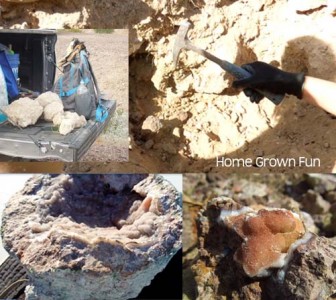Holidays around here are usually an adventure. Our extended families are on the other side of the country so we seek out some kind of nature activity. This year’s Thanksgiving was spent out in the desert with a rock club hunting for nodules and geodes.
What are Geodes
GEODES: You’ve probably seen them in gift or rock shops. Geodes are round or oblong rocks that form inside holes and crevices of sedimentary rock or bubbles in volcanic flows. Minerals seep into the holes and harden. The outer shell hardens first while the inside remains partially hollow. Geodes are actually porous so more minerals get in and coat the inside. Over millions of years crystals form. When a geode is broken or cut open you’ll see amethyst, quartz, agate or other minerals. The outside of a geode is bumpy and might resemble a head of cauliflower covered in dust!
NODULES: A nodule is a geode that is completely filled. It looks like a geode on the outside but it’s not hollow. Most nodules and geodes we came across were about golf ball size.
Geodes were not as easy to discover. Not being experts, it’s hard to tell the different between geodes and nodules – specific dig sites are known for specific specimens. Both have weird looking bumps on the outside. There were also lots of pieces of geodes on the ground even far away from the dig site. We took back less than a dozen whole geodes from the digs.
specific specimens. Both have weird looking bumps on the outside. There were also lots of pieces of geodes on the ground even far away from the dig site. We took back less than a dozen whole geodes from the digs.
Where Can I Find Geodes
SPECIFIC LOCATIONS: Without a guide, we would have gotten lost. We stumbled upon old mines, found pieces of geodes on the surface and dug into mountains looking for layers of ash and greenish rock, indicating there might be pockets of treasure. The area was close to the Arizona border near Blythe, CA near Wiley Well.
We dry camped for only 4 days but could have stayed twice as long wandering around, not caring what we looked or smelled like.
See the list below for sites in the U.S.
HOW TO GO ON A GEODE HUNT: If you might be interested in field trips like this, contact your state’s gem and mineral society or simply do a search for gem and mineral clubs in your area. Many times, the field trips are free! Annual dues for these clubs is low. They have tools and machines you can use later to cut, polish and grind your stones – also free or low cost depending on the club. I like my finds to remain unpolished but everyone’s got their own style. In the Southern California area I can recommend the Conejo Valley or Oxnard Clubs. Both clubs have a kids division called Pebble Pups.
How to Open a Geode
Depending on the type of geode and suspected interior, you have several options for opening up a geode. You can saw it open with a special blade. You can chisel it open by scoring it at several points around the rock. Or you can smash it open.
SMASH IT OPEN: This method is popular with kids and for smaller, less valuable geodes. The best way to smash a geode open is to put it inside a sock or cloth and strike it on a hard surface – preferably not a beautiful granite counter top! Smashing is is just that. You’ll get lots of fragments and no clean breaks.
SAW IT OPEN: The geodes we discovered could be sawed in two but by doing this we run the risk of messing up the crystals inside. Many folks still use this method because then they can polish it and make it look extra pretty. If you join a rock club in your area they will probably have a shop with specialized lapidary tools that can cut through your geode easily. You should use the proper saw to avoid injury.
SQUEEZE IT OPEN: Another method that would work well is with a soil pipe cutter. It uses a chain with blades to squeeze and cut the rock open. We have never done this before but it sound like one of the best techniques to use if you will be collecting geodes in the rough more often. Sometimes you can rent pipe cutters from home improvement or equipment centers.
CHISEL AND HAMMER: We like the natural look and so we’ll chisel our geodes open. They tend to break apart with a natural break keeping the crystals in tact. We’ll be experimenting with ways to clean up the outside. Do research on the type of geode you have to find out if chiseling will work better.
This weekend we’re chiseling open the large one in the image at the top of this article. It may not have anything special in it but that’s part of the fun!
Popular Geode Sites in the U.S.
There are probably geodes in almost every state in the U.S. Here are some more well known areas:
Keokuk, Iowa
Missouri, Dugway
Hall’s Gap and King’s Mountain, KY
Georgetown, OH
Southwest lower MI gravel pits
Hauser Geode Beds, near Blythe, CA plus Straw Bed, Cinnamon Bed, Potato Patch in the same area
Dale Hollow, Tennessee
Walker Valley, Redtop Mt. and Little Naches WA
Rockhound State Park just south of Deming, NM


